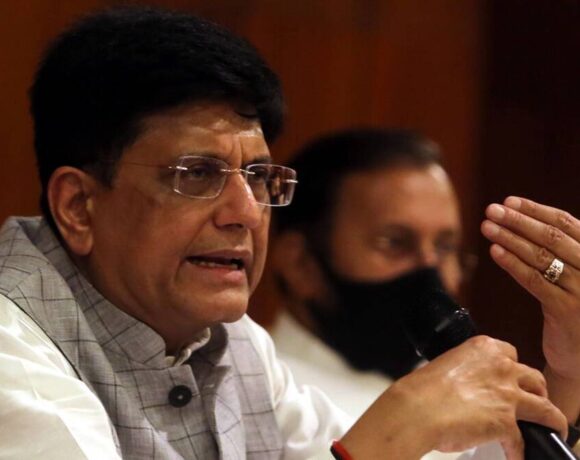

The Ministry of Home Affairs Friday extended the nationwide lockdown for two more weeks – now ending on Monday, May 17. In an order issued this evening. “After a comprehensive review and in view of the lockdown measures having led to significant gains in the Covid-19 situation, the government has decided to further extend the lockdown,” the order read.
The MHA further said a limited number of activities will remain prohibited across the country, irrespective of the zones, including travel by air, rail, metro and inter-state movement by road; running of schools, colleges, and other educational and training/coaching institutions.
Here’s what all will not be allowed under the new guidelines issued today irrespective of the zone
* Travel by air, rail, metro and inter-state movement by road
* Running of schools, colleges and other educational, training, coaching institutions
* Hospitality services including hotels and restaurants
* Places of large public gatherings such as cinema halls, malls, gyms, sports complexes
* Social, political, cultural and other kinds of gatherings
* Religious places, places of worship for public
However, movement of persons by air, rail and road is allowed for select purposes and for those permitted by the MHA.
The Ministry of Home Affairs Friday extended the nationwide lockdown for two more weeks – now ending on Monday, May 17. In an order issued this evening. “After a comprehensive review and in view of the lockdown measures having led to significant gains in the Covid-19 situation, the government has decided to further extend the lockdown,” the order read.

The MHA further said a limited number of activities will remain prohibited across the country, irrespective of the zones, including travel by air, rail, metro and inter-state movement by road; running of schools, colleges, and other educational and training/coaching institutions. Read in Malayalam
Here’s what all will not be allowed under the new guidelines issued today irrespective of the zone
* Travel by air, rail, metro and inter-state movement by road
* Running of schools, colleges and other educational, training, coaching institutions
* Hospitality services including hotels and restaurants
* Places of large public gatherings such as cinema halls, malls, gyms, sports complexes
* Social, political, cultural and other kinds of gatherings
* Religious places, places of worship for public
However, movement of persons by air, rail and road is allowed for select purposes and for those permitted by the MHA.
The MHA order has also prescribed measures for the “well being and safety of persons.”
The order states that movement of individuals in all zones for all non-essential activities, shall remain strictly prohibited between 7 pm and 7 am. Local authorities shall issue orders imposing Section 144 and ensure strict compliance, the order states.
In all zones, those above the age of 65, persons with co-morbidities, pregnant women and children below the age of 10 years, shall stay at home except for meeting essential requirements and for health purporses.
OPDs and medical clinics shall be permitted to operate in Red, Orange and Green Zones with social distancing norms and other preventive measures. However, these will not be permitted in containment zones.
lockdown extended, lockdown extended guidelines, new guidelines red zone, what is allowed in red orange green zone, covid 19 lockdown extended new guidelines, lockdown what is allowed, new lockdown rules india, indian express Supply of essential items to residents of containment zone at sector 30 through CTU buses with health care workers wearing PPE kits. Express Photo by Jasbir Malhi
These activities are not allowed in Red Zones
* Plying of cycle rickshaws and auto rickshaws;
* Running of taxis and cab aggregators;
* Intra-district and inter-district plying of buses;
* Barber shops, spas and saloons
Here’s what all is allowed in Red Zones
* Movement of individuals and vehicles is allowed only for permitted activities, with a maximum of 2 persons (besides the driver) in four-wheeler vehicles, and with no pillion rider in the case of two-wheelers
* Industrial establishments in urban areas – Special Economic Zones (SEZs), Export Oriented Units (EOUs), industrial estates and industrial townships with access control have been permitted
* Manufacturing units of essential goods, including drugs, pharmaceuticals, medical devices, their raw material and intermediates; production units, which require continuous process, and their supply chain; manufacturing of IT hardware; jute industry with staggered shifts and social distancing; and, manufacturing units of packaging material
* Construction activities in urban areas have been limited to in-situ construction (where workers are available on site and no workers are required to be brought in from outside) and construction of renewable energy projects.
* Shops in urban areas, for non-essential goods, are not allowed in malls, markets and market complexes.
* All industrial and construction activity in rural areas, including MNREGA works, food-processing units and brick-kilns
* In rural areas, without distinction of nature of goods, all shops except in shopping malls, are permitted
* All agricultural activities – sowing, harvesting, procurement and marketing operations in the agricultural supply chain are permitted.
lockdown extended, lockdown extended guidelines, new guidelines red zone, what is allowed in red orange green zone, covid 19 lockdown extended new guidelines, lockdown what is allowed, new lockdown rules india, indian express A petrol pump attendant wears a Personal Protective gear while filling petrol in New Delhi on Thursday. Express Photo by Tashi Tobgyal
* Animal husbandry activities are fully permitted including fisheries
* All plantation activities are allowed, including their processing and marketing.
* All health services (including AYUSH) are to remain functional, including transport of medical personnel and patients through air ambulances
* Financial sector to remain open largely. This includes banks, non-banking finance companies, insurance and capital market activities, and credit co-op societies
* Operation of homes for children, senior citizens, destitutes, women and widows, etc
* Operation of anganwadis
* Public utilities in power, water, sanitation, waste management, telecommunication and internet
* Courier and postal services
* E-Commerce activities, in the Red Zones, are permitted only in respect of essential goods
* Private offices can operate with upto 33% strength as per requirement, with the remaining persons working from home
* All standalone (single) shops, neighborhood (colony) shops and shops in residential complexes are permitted to remain open in urban areas, without any distinction of essential and non-essential.
* All Government offices shall function with senior officers of the level of Deputy Secretary and above at full strength, and the remaining staff attending upto 33% as per requirement. Defense and Security services, Health and Family Welfare, Police, Prisons, Home Guards, Civil Defence, Fire and Emergency Services, Disaster management and related services, National Informatics Centre (NIC), Customs, Food Corporation of India (FCI), National Cadet Corps (NCC), Nehru Yuvak Kendra (NYK) and Municipal services shall function without any restrictions; delivery of public services shall be ensured and necessary staff will be deployed for such purpose.
* Print and electronic media, IT and IT enabled services, data and call centres, cold storage and warehousing services, private security and facility management services, and services provided by self-employed persons, except for barbers etc.
* Manufacturing units of essential goods, including drugs, pharmaceuticals, medical devices, their raw material and intermediates; production units, which require continuous process, and their supply chain
* Jute industry with staggered shifts and social distancing; and manufacturing of IT hardware and manufacturing units of packaging material will continue to be permitted.
lockdown extended, lockdown extended guidelines, new guidelines red zone, what is allowed in red orange green zone, covid 19 lockdown extended new guidelines, lockdown what is allowed, new lockdown rules india, indian express Vehicles seized by Pune Police for violating the lockdown have been lined up at Vishrantwadi police station. Express Photo by Pavan Khengre
What all is allowed in Orange Zones
In addition to activities permitted in Red Zone, below are the additional activities that are now permitted
taxis and cab aggregators will be permitted with 1 driver and 1 passenger only.
Inter-district movement of individuals and vehicles will be allowed for permitted activities only.
Four wheeler vehicles will have maximum two passengers besides the driver and pillion riding will be allowed on two-wheelers.
What all is allowed in Green Zones
All activities are permitted except the limited number of activities which are prohibited throughout the country, irrespective of the Zone. Buses can operate with upto 50% seating capacity and bus depots can operate with upto 50% capacity.
These are the nationwide guidelines for workplaces
* Wearing of face cover is compulsory in all work places and adequate stock of such face covers shall be made available.
* All persons in charge of work places shall ensure social distancing as per the guidelines issued by Ministry of Health and Family Welfare, both within the work places and in company transport.
Social distancing at work places shall be ensured through adequate gaps between shifts, staggering the lunch breaks of staff, etc.
* Provision for thermal scanning, hand wash and sanitizer preferably with touch free mechanism will be made at all entry and exit points and common areas. In addition, sufficient quantities of handwash and sanitizer shall be made available in the work places.
* Frequent sanitization of entire workplace, common facilities and all points which come into human contact e.g. door handles etc., shall be ensured, including between shifts.
* Persons above 65 years of age, persons with co-morbidities, pregnant women and children below the age of 10 years shall stay at home, except for meeting essential requirements and for health purposes.
* Use of Arogya Setu app shall be made mandatory for all employees, both private and public. It shall be the responsibility of the Head of the respective Organizations to ensure 100% coverage of this app among the employees.
* Large physical meetings to be avoided.
* Hospitals/ clinics in the nearby areas, which are authorized to treat COVID-19 patients, should be identified and list should be available at work place all the times. Employees showing any symptom of COVID-19 should be immediately sent for check up to such facilities. Quarantine areas should be earmarked for isolating employees showing symptoms till they are safely moved to the medical facilities.
* Arrangements for transport facilities shall be ensured with social distancing, wherever personal/ public transport is not feasible.
* Intensive communication and training on good hygiene practices shall be taken
These are the nationwide guidelines for public places
* Wearing of face cover is compulsory in all public places.
* All persons in charge of public places and transport shall ensure social distancing as per the guidelines issued by Ministry of Health and Family Welfare.
* No organization/ manager of public place shall allow gathering of 5 or more
persons.
* Marriages related gatherings shall ensure social distancing, and the maximum number of guests allowed shall not be more than 50.
* Funeral/ last rites related gatherings shall ensure social distancing, and the maximum numbers allowed shall not be more than 20
* Spitting in public places shall be punishable with fine, as may be prescribed by the State/ UT local authority.
* Consumption of liquor, paan, gutka, tobacco etc. in public places is not allowed.
* Shops selling liquor, paan, gutka, tobacco etc. will ensure minimum six feet distance (2 gaz ki doori) from each other, and also ensure that not more than 5 persons are present at one time at the shop
The MHA order further states that across the zones, all goods traffic is to be permitted. “No State/ UT shall stop the movement of cargo for cross land-border trade under Treaties with neighbouring countries. No separate pass of any sort is needed for such movement, which is essential for maintaining the supply chain of goods and services across the country during the lockdown period,” the order states.
The MHA order has also prescribed measures for the “well being and safety of persons.”
The order states that movement of individuals in all zones for all non-essential activities, shall remain strictly prohibited between 7 pm and 7 am. Local authorities shall issue orders imposing Section 144 and ensure strict compliance, the order states.
In all zones, those above the age of 65, persons with co-morbidities, pregnant women and children below the age of 10 years, shall stay at home except for meeting essential requirements and for health purporses.
OPDs and medical clinics shall be permitted to operate in Red, Orange and Green Zones with social distancing norms and other preventive measures. However, these will not be permitted in containment zones.
These activities are not allowed in Red Zones
* Plying of cycle rickshaws and auto rickshaws;
* Running of taxis and cab aggregators;
* Intra-district and inter-district plying of buses;
* Barber shops, spas and saloons
Here’s what all is allowed in Red Zones
* Movement of individuals and vehicles is allowed only for permitted activities, with a maximum of 2 persons (besides the driver) in four-wheeler vehicles, and with no pillion rider in the case of two-wheelers
* Industrial establishments in urban areas – Special Economic Zones (SEZs), Export Oriented Units (EOUs), industrial estates and industrial townships with access control have been permitted
* Manufacturing units of essential goods, including drugs, pharmaceuticals, medical devices, their raw material and intermediates; production units, which require continuous process, and their supply chain; manufacturing of IT hardware; jute industry with staggered shifts and social distancing; and, manufacturing units of packaging material
* Construction activities in urban areas have been limited to in-situ construction (where workers are available on site and no workers are required to be brought in from outside) and construction of renewable energy projects.
* Shops in urban areas, for non-essential goods, are not allowed in malls, markets and market complexes.
* All industrial and construction activity in rural areas, including MNREGA works, food-processing units and brick-kilns
* In rural areas, without distinction of nature of goods, all shops except in shopping malls, are permitted
* All agricultural activities – sowing, harvesting, procurement and marketing operations in the agricultural supply chain are permitted.
* Animal husbandry activities are fully permitted including fisheries
* All plantation activities are allowed, including their processing and marketing.
* All health services (including AYUSH) are to remain functional, including transport of medical personnel and patients through air ambulances
* Financial sector to remain open largely. This includes banks, non-banking finance companies, insurance and capital market activities, and credit co-op societies
* Operation of homes for children, senior citizens, destitutes, women and widows, etc
* Operation of anganwadis
* Public utilities in power, water, sanitation, waste management, telecommunication and internet
* Courier and postal services
* E-Commerce activities, in the Red Zones, are permitted only in respect of essential goods
* Private offices can operate with upto 33% strength as per requirement, with the remaining persons working from home
* All standalone (single) shops, neighborhood (colony) shops and shops in residential complexes are permitted to remain open in urban areas, without any distinction of essential and non-essential.
* All Government offices shall function with senior officers of the level of Deputy Secretary and above at full strength, and the remaining staff attending upto 33% as per requirement. Defense and Security services, Health and Family Welfare, Police, Prisons, Home Guards, Civil Defence, Fire and Emergency Services, Disaster management and related services, National Informatics Centre (NIC), Customs, Food Corporation of India (FCI), National Cadet Corps (NCC), Nehru Yuvak Kendra (NYK) and Municipal services shall function without any restrictions; delivery of public services shall be ensured and necessary staff will be deployed for such purpose.
* Print and electronic media, IT and IT enabled services, data and call centres, cold storage and warehousing services, private security and facility management services, and services provided by self-employed persons, except for barbers etc.
* Manufacturing units of essential goods, including drugs, pharmaceuticals, medical devices, their raw material and intermediates; production units, which require continuous process, and their supply chain
* Jute industry with staggered shifts and social distancing; and manufacturing of IT hardware and manufacturing units of packaging material will continue to be permitted.
lockdown extended, lockdown extended guidelines, new guidelines red zone, what is allowed in red orange green zone, covid 19 lockdown extended new guidelines, lockdown what is allowed, new lockdown rules india, indian express Vehicles seized by Pune Police for violating the lockdown have been lined up at Vishrantwadi police station. Express Photo by Pavan Khengre
What all is allowed in Orange Zones
In addition to activities permitted in Red Zone, below are the additional activities that are now permitted
taxis and cab aggregators will be permitted with 1 driver and 1 passenger only.
Inter-district movement of individuals and vehicles will be allowed for permitted activities only.
Four wheeler vehicles will have maximum two passengers besides the driver and pillion riding will be allowed on two-wheelers.
What all is allowed in Green Zones
All activities are permitted except the limited number of activities which are prohibited throughout the country, irrespective of the Zone. Buses can operate with upto 50% seating capacity and bus depots can operate with upto 50% capacity.
These are the nationwide guidelines for workplaces
* Wearing of face cover is compulsory in all work places and adequate stock of such face covers shall be made available.
* All persons in charge of work places shall ensure social distancing as per the guidelines issued by Ministry of Health and Family Welfare, both within the work places and in company transport.
Social distancing at work places shall be ensured through adequate gaps between shifts, staggering the lunch breaks of staff, etc.
* Provision for thermal scanning, hand wash and sanitizer preferably with touch free mechanism will be made at all entry and exit points and common areas. In addition, sufficient quantities of handwash and sanitizer shall be made available in the work places.
* Frequent sanitization of entire workplace, common facilities and all points which come into human contact e.g. door handles etc., shall be ensured, including between shifts.
* Persons above 65 years of age, persons with co-morbidities, pregnant women and children below the age of 10 years shall stay at home, except for meeting essential requirements and for health purposes.
* Use of Arogya Setu app shall be made mandatory for all employees, both private and public. It shall be the responsibility of the Head of the respective Organizations to ensure 100% coverage of this app among the employees.
* Large physical meetings to be avoided.
* Hospitals/ clinics in the nearby areas, which are authorized to treat COVID-19 patients, should be identified and list should be available at work place all the times. Employees showing any symptom of COVID-19 should be immediately sent for check up to such facilities. Quarantine areas should be earmarked for isolating employees showing symptoms till they are safely moved to the medical facilities.
* Arrangements for transport facilities shall be ensured with social distancing, wherever personal/ public transport is not feasible.
* Intensive communication and training on good hygiene practices shall be taken
These are the nationwide guidelines for public places
* Wearing of face cover is compulsory in all public places.
* All persons in charge of public places and transport shall ensure social distancing as per the guidelines issued by Ministry of Health and Family Welfare.
* No organization/ manager of public place shall allow gathering of 5 or more
persons.
* Marriages related gatherings shall ensure social distancing, and the maximum number of guests allowed shall not be more than 50.
* Funeral/ last rites related gatherings shall ensure social distancing, and the maximum numbers allowed shall not be more than 20
* Spitting in public places shall be punishable with fine, as may be prescribed by the State/ UT local authority.
* Consumption of liquor, paan, gutka, tobacco etc. in public places is not allowed.
* Shops selling liquor, paan, gutka, tobacco etc. will ensure minimum six feet distance (2 gaz ki doori) from each other, and also ensure that not more than 5 persons are present at one time at the shop
The MHA order further states that across the zones, all goods traffic is to be permitted. “No State/ UT shall stop the movement of cargo for cross land-border trade under Treaties with neighbouring countries. No separate pass of any sort is needed for such movement, which is essential for maintaining the supply chain of goods and services across the country during the lockdown period,” the order states.


















